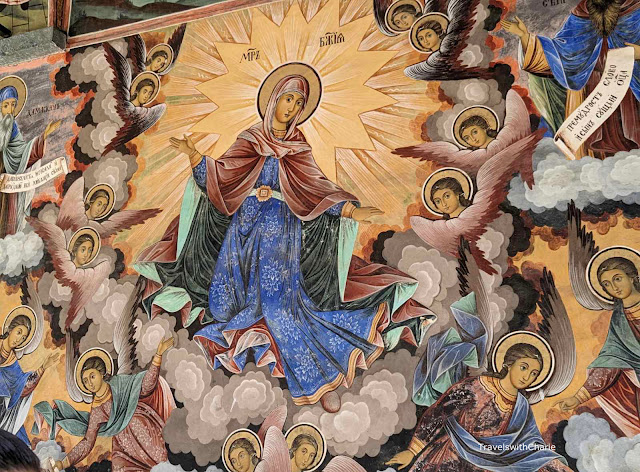Rila Monastery sits in a forested valley surrounded by snow capped mountain peaks. The setting can’t get any more wholesome with the exception that this is a popular tourist and pilgrimage destination. Weekends are the worst days to visit when the Church of the Nativity of the Virgin Mother is so crowded, there’s little room to move inside the stunning church. We got there after lunch on a Sunday and the traffic on the narrow lane road at the back of the monastery was atrocious. The crowds thinned after three p.m. so we could get a closer look at the outdoor frescoes.
All Eastern Orthodox churches depict the Christ Pantocrator in the central dome of the Church. Pantocrator means the Almighty and the ruler of all. There are initials on both sides of the head of the Pantocrator, IC and XC. IC are the first and last letters of Jesus in the Greek alphabet (Iota and Sigma) and XC (Chi and Sigma) are the first and last letters for Christ. This Pantocrator fresco is on the outdoor portico. Taking photos is not allowed inside the Church which is one of the most beautiful Eastern Orthodox churches I’ve visited. It has a gilded iconostasis and dazzling chandeliers.
Mary, the mother of God is surrounded by angels.
This fresco of St. Michael vanquishing the devil is on the front portico by the main portal.
St. John who lived in the cave nearby founded the monastic group in the 10th century. His students built the monastery complex which was rebuilt in the 14th century and again in the 19th century when it was destroyed by fire. Only the Hrelja Tower, a small church beside it and the gates remain of the original structures. The image above is of the east portico with the fresco of the Last Judgement.
Last Judgement
The Holy Spirit is on the altar in front of the cross. In the lower center panel are angels pushing away the demons. Hell cuts a swath down the length of the painting and demons pull sinners down the abyss. On the left panel are the people who are in heaven and those about to enter through the gate of heaven.Detail from the Last Judgement. On this panel are the people who are entering the gate of heaven and those who are already inside the gate. The three seated men on the lower left panel are the evangelists; Jeremiah, Isaiah and Ezekiel. Their names are written above their heads. St. John the Baptist is holding the cross.
View of the east side portico overlooking Hrelja Tower. Note the domes of the Church of the Holy Virgin and the arcaded porticos painted in black and white stripes.
Hrelja Tower
Hrelja Tower is named after the feudal lord who restored the monastery complex and built the tower in the 14th century. The monks used this tower for defense purposes.This fresco depict passages from these books of the Bible:
John 1.29-32: The next day John (the Baptist) saw Jesus coming toward him, and said, “Behold! The Lamb of God who takes away the sin of the world! This is He of whom I said: ‘After me comes a Man who is preferred before me, for He was before me’.”
Revelation 16: Revelation (or Apocalypse) is the last book of the Bible. Chapter 16 is about the seven angels pouring out the wrath or judgement of God upon the wicked.
Mary with the Child Jesus, Evangelists and Saints of the Eastern Orthodox Church
An interchange between the angels and demons. This panel is found on the west portico.
Rila Monastery is a UNESCO World Heritage site.
How to get there and where to stay:
I took a small group tour with Get Your Guide and it was too rushed. We probably spent an hour and a half at the monastery which allowed us to skim through the Church and outdoor frescoes. There was no time to go to the museum. To properly appreciate all the monastery has to offer, I suggest spending an entire day and perhaps stay the night there as well. There are rooms available for overnight stays in the monastery. Make reservations at the monastery here: https://www.rilamonastery.info/accommodation/.
A bus leaves daily from Sofia Bus Station (next to the train station) to Rila Monastery. The journey takes two hours and a half. Another option is to take a tourist bus to Rila from Alexander Nevski Cathedral in Sofia.
Where to eat:
We stopped by the Gorski Kut Hotel and Restaurant which is on the way to the monastery. I ordered the trout which was caught from the stream below the restaurant. It was served with a generous amount of potatoes. Ate all the fish and left some of the potatoes.














